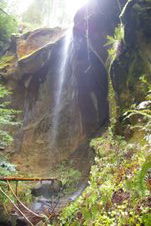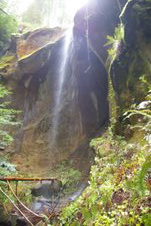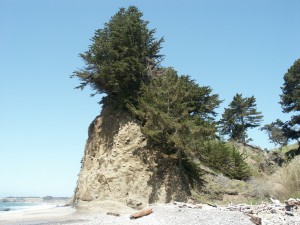|
1897: Wealthy Pioneer G.R. Borden lived in the Purissima


SAN MATEO PIONEER GONE.
G. R. Borden Passes Away at His Home
in Purissima
REDWOOD CITY, Cal., July 23.— G. R.
Borden, a wealthy pioneer resident of this
county, died at his home at Purissima, on
the coast side, yesterday. Borden landed
in this section in 1853, locating near Half –
moon Bay, and had the distinction of
being the first white man to cross the
Santa Cruz range of mountains and make
his home in that place. Tie late James
Peace, who deserted his vessel in San
Francisco Bay some years previous, was
undoubtedly the first white resident.
Borden was born near L.ttie Falls,
N. V., in 1812, and during bis boynood
was a schoolmate and intimate friend of
the late Senator Stanford. Borden was
one of the builders of the Erie canal, hav –
ing had charge of the construction of fifty
miles near Utica City.
The deceased was extensively engaged
in the manufacture of shingles and was
associated with G. P. Hartley of this city,
forming one co-partnership, and with
R. H. Hatch of the coast side in a similar
enterprise. His real property consists
of a valuable tract ol timber land in
Purissima Canyon which is worth $100,000.
He leaves one son. The burial took place
today at Halfmoon Bay, under the aus –
pices of the Masonic fraternity.
Coastside WaterFalls: Story/Photos by John Vonderlin
19th Century Storm: Condition of things at Half Moon Bay (after “the late storm”)
Thanks to John Vonderlin
Email John ([email protected])
From the January 14, 1862 issue of the Daily Alta, published in San Francisco
Condition of things at Half Moon Bay
From a gentleman who arrived this afternoon from Half Moon Bay, we learn that considerable damage was done at that place by the late storm. Three-fourths of the bridge at Spanish Town was carried away by the floods. A man named Ransom H. Wood, recently from Contra Costa, and originally from Vermont, was drowned in an attempt to cross the Creek, on Saturday morning.
The surf struck his boat and capsized her. He was then carried out by the undertow, and all efforts to save him proved unavailing. Our informant also tells us what the Peruvian bark, the loss of which was narrated in the “Alta” this morning, went to pieces twenty-four hours after she struck. She is a total loss. He knows nothing of the other vesselwhich, it was said, went ashore further south.
———–
Such a fierce storm deserves an entry in “Wikipedia.” To read, please click here
———–
The bridge mentioned in the above Daily Alta article may very well be the concrete one built in 1900—that’s still there, near the Pasta Moon restaurant. The bridge was said to be the first steel-reinforced concrete bridge in the world. Before that, it must have regularly washed out during winter storms.
————-
[This story, also published by the Daily Alta, comes from a correspondent in Purisima!.)
The Flood of 1862.
——–
Half Moon Bay District.
We are indebted to Messrs. Miller & Hopkins” Half Moon Bay Express for the following from: Purisima, January 10, 1862
The flood has been most disastrous on this creek, especially to M.N.C. Lane. About two or three acres of ground slid into the creek above the saw mill, overwhelming th barn, and killing instantly tow valuable horses and four oxes. It then struck the Suelling House, completely demolishing it.
Mr. Lane had just completed his house and furnished it with new and costly furniture, which is all a perfect wreck.
The family saved themselves with difficulty, having only four or five minutes notice before the water bore the house away, and dashed it in piece among redwood trees, hundreds of feet long, and many of them six or eight feet in diameter. The most remarkable incident that occurred during the disaster was the saing of the piano forte. While almost every other article was either crushed to fragments, or borne away by the resistless torrent, the piano was lifted on the top of a large redwood log, and deposited unharmed, some distance below the general wreck.
All along the creek, roads and bridges are completely washed away, or much injured as to be impassable, and every hillside bears evidence, in numerous slides, of the devastating power of the storms.
A CATARACT
Saturday morning presented a scene seldom witnessed in our quiet community. After Purissima has a fall of about seventy feet over the bluff, into the ocean. Over this cataract, borne by the turbid flood, were hurled in wild confusion the debris of denuded ranches, dwellings, outhouses and fences, mixed with giant redwood trees and logs, and the whole precipitated into the boiling surf and thrown high upon the jagged rocks of this ironbound coast.
——-
Solved: The Monty Parker Mystery, A South Coast Story
Solved by Ashaleigh Parker 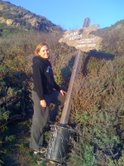
with adventurers John Vonderlin 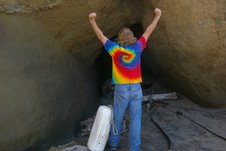
and Larry Fitterer
To read the story: please click here
La Peninsula: How Maverick’s Works by Montara resident Bruce Jenkins
& The Many Sides of Pigeon Point by JoAnne Semones
Review by John Vonderlin
Email John ([email protected])
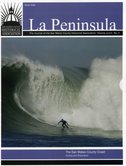

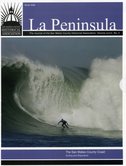
Hi June,
I was just reading the Winter issue of “La Peninsula,” the Journal of the San Mateo Historical Association. The cover and first twelve pages are devoted to an excellent article about Maverick’s by Bruce Jenkins, a Montara resident. Bruce, the advisor to the History Museum’s interactive Maverick’s exhibit and author of several big wave surfing books, knows his subject really well and so do we after reading the article. He’s got good inside stuff, covers the history well, and also delves into the spirit of the unusual group of surfers who risk their lives challenging the monsters that can build, collapse and explode at our local, world famous surf spot. With sponsorship secured, invitees picked, all we need now is for Mother Nature to co-operate, and we’ll once again be exposed to one of the most daring sporting events anywhere.
With the great low tides over the next few days, if I can arrange it, I might try to make a circum-Pillar trip and get some pictures of Maverick’s, Mushroom Rock, etc. from the foot of the Point, something impossible during the event.
The other article completing the issue is “The Storied Waters of Pigeon Point,” by JoAnne Semones.” JoAnne, the author of “Shipwrecks, Scalawags, and Scavengers,” an excellent chronicling of a century of the tragedy-filled Maritime history of the treacherous waters the Pigeon Point Lighthouse was built to neuter, has added new material from rare oral histories and personal interviews with the keepers’ families and local residents. She has included historic smuggler stories that should be great background for some of the tales I’m hoping Rob Tillitz will share about his experiences in these waters. Enjoy. John
——–
1893: HMB, isolated, with the finest beach in CA
From John Vonderlin
Email John ([email protected])
Hi June,
This is from the 1893 book, “A Memorial and Biographical History of the Central Coast Counties…” by Henry D. Barrows and Luther Ingersoll. It is available on Archive.org. The text contains errors because of the type recognition system.
HALFMOON BAY.
Of all the towns in San Mateo this most
wears the air of the pre-American regime.
It is a quaint, rambling place with as much
variety in its architecture as there is in the
patois of its people. Situated in the beauti-
ful and fertile Pilarcitos valley, on the border
of that serai-luna of water, from which it
takes its name, it is one of Nature’s chosen
spots, but unfortunate in its isolation. The
valley spreads out into thousands of acres,
through which the Pilarcitos creek makes its
way to the sea. The climate is not excelled
in its loveliness by any on the ocean side, not
excepting the much vaunted Santa Barbara
channel. From the town there stretches
away to the north for miles a clean gradually
shoaling beach, the finest without exception
in California. From Pilar point, the north-
ern headland, a reef of rocks. Just discernible
at low water by the break of the waves, ex-
tends southward for two miles, forming a
natural breakwater and rendering the beach
absolutely free from undertow, high rollers
and every possible danger. Here is the
grandest bathing place in the world, prepared
and protected by Nature. The building of the
coast railroad will deflect the great army of
people who annually flock to Monterey and
places farther south. Half moon Bay will
be rediscovered and the borders of the cres-
cent be ornamented with summer hotels and
villa residences. There is room for all in the
spacious waters of the bay and the most ele-
gant sites for hotels or summer homes to be
found anywhere on tlie coast.
This valley was the seat of the Miramontez
and Vasquez families long before the appear-
ance of the American settler, and by all old
residents the town is still called Spanishtown.
The old adobe homestead is still here, but
before many years will have yielded to the
assaults of time and become an unnoticed
tumulus. There is something in the atmos-
phere of Spanishtown that breeds a spirit of
independence. The people believe in them-
selves. Not that they consider that they are
the salt of the earth entirely, but they love
the valley where they have made their homes
and cling to it as to a family tie which they
are loth to sunder. The business of the
place is drawn mainly from dairymen and
farmers. At Amesport, a short distance
north of town, there is a wharf and warehouse
where coasting vessels call and take away the
butter, cheese and beans.
In the romantic canon of the San Greg-
orio, where giant redwoods cast their elon-
gated shadows and the murmuring waters of
the stream sing a ceaseless lullaby, Mr. John
H. Sears, one of the pioneers of San Mateo,
is passing the afternoon of his life. Here
he has built a hotel and store and does not
lack for company. During the summer sea-
son the woods ring with the merry voices of
campers and the hotel and cottages are
crowded to repletion. No more charming
place can be found anywhere in the State.
It is reached by stage from Redwood City
over a fine road, but so strong is the impres-
sion of a primeval wilderness when once in
the heart of the forest that even the rattle of
the daily coach and the receipt of diurnal
messages from home does not suffice to break
it. White tents peep through the bushes at
every turn, but that serves to highten the
illusion. You are out of the world when
you know you are in it. The days are spent
in eager angling after the elusive trout with
which the stream abounds. In the evening
there are concerts in the camps; bear stories
to be swapped with the landlord; compara-
tive fish yarns by young men, who could’nt
catch three trout in a week, but who love to
talk about it; a championship game at crib-
bage with the drummer, who knows it all
and then to be abed for seven hours in
deepest oblivion. It is a joyful place, un-
conventional, unaffected, but unexceptionable
in the. personnel of its patrons. A writer in
one of the many visits to this favorite spot
was introduced to a camp, where the party
was almost entirely composed of ladies.
“When out of hearing of the camp he asked
the lady who acted as chaperon of the party
how they managed to enjoy themselves with-
out the aid of the sterner sex. ” Enjoy
themselves?” said she in a burst of enthus-
iasm, ” oh, yes; they do! We have plenty of
horses, wear divided skirts, ride astride like
men and have such lots of fun.” Of course
they did. It was harmless, healthful fun,
and they were free to throw their souls into
it. It was an active exercise of body and
mind in a pure air, and with such surround-
ings as induced joyful hearts, consuming ap-
petites and refreshing sleep. Every day so
spent added a year to their lives. It is not
strange that when the sun dips to the south
they look forward with eager anticipation to
the June days when they shall again set up
their tents at La Honda.
Before you put the fish back in Purissima Creek….
I’ve changed my mind, says John Vonderlin.
Email John ([email protected])
John Vonderlin: How did the fish get into tiny Purissima Creek anyway?
Story/Photos John Vonderlin
Email John ([email protected])
[Image: Town of Purisima (also spelled Purissima), circa 1870s.] 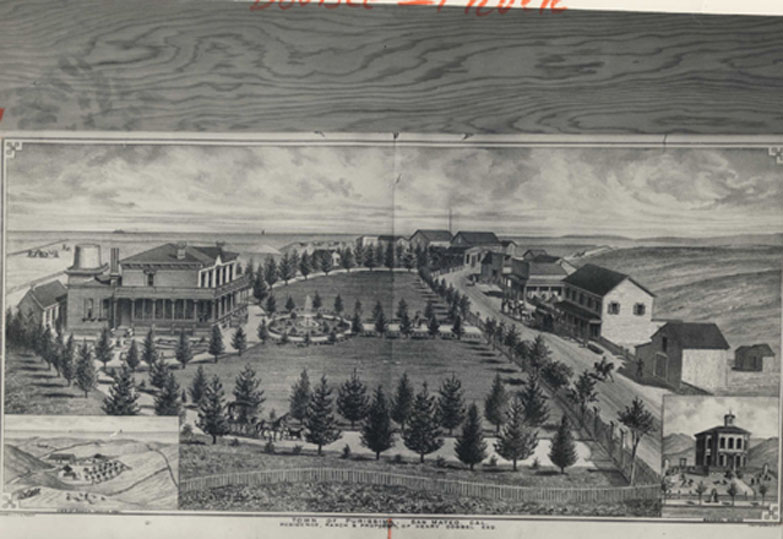
Hi June,
I think you’ll find this an interesting addition to the handful of excellent stories you have posted on HMB concerning Purisima (Purissima). This is an article from “The San Francisco Call,” of April 12, 1900.
Legislation on Fishing in San Mateo
Necessity of Closing Streams Another Month Questioned
On the last day of March, in an article on the trout streams of California the fishing expert of “The Call” commented adversely on the action of the Supervisors of San Mateo in passing an ordinance closing the fishing season until May 1. It was held that as all the fish have spawned by April 1 the closing of the season will be but of little benefit. As none of the adjoining counties have such a law, confusion to the anglers is sure to develop. The editor of “The Coast Advocate” of Halfmoon bay (sic) comes valiantly to the aid of the Superviors. (sic) Unfortunately, for him his argument is weak, as his various premises are not accurate.
The controversy was submitted by The Call to John P. Babcock, chief deputy of the California State Fish Commission and an authority on the game and food fish of the coast. Mr. Babcock supports unqualifiedly the statements of The Call in an interesting communication. He says:
The Coast Advocate is in error in saying that the “Purissima Creek is the most important trout stream in San Mateo County, and that it is not surpassed as a fishing ground by any stream in California.” The Purissima Creek does not compare favorably as a fishing stream with the San Gregoria, (sic) the Pescadero, or Butana, (sic) or their main tributaries.
The fish in the Purissima are numerous, but small. An eight-inch fish is a big one in that stream, and one of ten inches a “whale.”
The Purissima, however, is one of the best known streams in San Mateo County. The wayside inn established some forty years ago by Richard Dougherty upon its bank near its mouth gave it its reputation. “The Purissima House” has no equal of a stopping place on the coast, but it was “Dick’s” care for travelers and his wife’s cooking that made it so attractive. The fishing for small fish was good. They were of fine flavor and Mrs. Dougherty knew just how to cook them and just what to serve with them. Any one who was so fortunate as to eat a meal prepared by Mrs. Dougherty talked of its excellence for days after.
As time went by it was noised about that you must have fished the Purissima to know the real joy of angling, so that at any time in the early part of the season you were sure to find congenial sports there, and even though there were no fish over eight inches in length your catch from the Purissima, you came home, well convinced that fish do not contribute all of “fishing.” It is curious how the fish did get into the Purissima and how they maintain themselves there, for they cannot enter from the sea, and up to the time of Dick Doughtery’s death a few years ago as far is known the stream was not stocked with fish from any other water. Yet year after year fish continued to multiply and furnish creel after creel of small trout to the anglers who visited its water. As to the spawning period of the fish in the Purissima the writer is not as well informed, but they “do not entirely cease spawning until after May 1 and not a third have completed their work by April 1st” as the Coast Advocate says. The wonder of them maintaining themselves in such a limited water course is more the mystery.
In all the thirty odd years Dougherty lived there the stream was fished each year by hundreds. When a stream will stand such a strain for such a length of time one may well believe that Dick was right when he said, “You can’t fish ’em all out.”
So far as the writer knows the spawning season of the trout in the Purissima does not differ materially from those other streams in the county, namely, December to April. There may be a few who have not deposited their spawn by April 1, but they are the exception. The embryo of the next season’s spawn is large enough in April to be noticeable. This is true ever of trout that have just spawned.
If the present close season was observed there would be no necessity for a longer season in San Mateo county. It is commonly stated that little or no attention was paid to the closed season this year in San Mateo. It is even stated on April 1 there was a well-beaten track on both sides of San Gregorio and Pescadero Creeks. If the peace officers and Supervisors of San Mateo County would take steps to enforce the closed season under State law it would be of more benefit to the streams and the anglers who go there.
————————————–
While I’ve been unable to locate any further information about “The Purissima House” or Mr. and Mrs. Dougherty, I believe I have a reasonable answer to how the fish got in the creek. The answer is glaciers. The present sea level that makes the Purisima Falls an obstacle to fish wishing to return to ancestral spawning grounds from the ocean, has only existed for a blink of an eye in geologic terms. As you can see from this map I’ve attached  that even ten thousand years ago the sea level was still about 100 feet lower then it is now with the shoreline several miles west of where it is now. The Falls themselves were still covered with softer rock and soil that was washed away by waves as the waters rose to their present level. My guess it was probably only in the last five thousand and possibly much more recently that the falls became an impassable obstacle to the returning fish. It might even have been in just the last thousand years, after the sea level became stabilized, that the forces of erosion, both the stream’s flow lowering the creekbed’s level and the receding coastline caused by the unrelenting pounding of waves, created this wonderful waterfall and gave the stay at home trout genetic dominion over this watershed.
that even ten thousand years ago the sea level was still about 100 feet lower then it is now with the shoreline several miles west of where it is now. The Falls themselves were still covered with softer rock and soil that was washed away by waves as the waters rose to their present level. My guess it was probably only in the last five thousand and possibly much more recently that the falls became an impassable obstacle to the returning fish. It might even have been in just the last thousand years, after the sea level became stabilized, that the forces of erosion, both the stream’s flow lowering the creekbed’s level and the receding coastline caused by the unrelenting pounding of waves, created this wonderful waterfall and gave the stay at home trout genetic dominion over this watershed.
My understanding is that the Cowell/Purisima Trail won’t be open until Spring because of the need to build three substantial bridges, but you can check out this area and the progress they’d made as of Oct by checking out California Coastal Records Project (CCRP) Pictures # 20080795 (Cowell Beach Access Point) south to #200809829 (Poppy Point viewing area) CCRP has recently added two series of looking-straight-down high altitude photos, of which Picture #199300128008 is of the Falls and the nearby area, which certainly must include the site of “The Purissima House,” that the Doughertys made famous. My guess is the bare brown oval just above the Falls was the site, but that’s just because I would have put it there if I was building it. Enjoy. John
————————–
 that I added a P to indicate where I think “The Purissima House” was. This leveled spot with the to-die-for view, is somewhat lower then the surrounding land, giving it some shelter from the wind, easy gravity flow water to it and the sound of the stream and falls nearby to soothe you. With all the land on the flat above I can’t think of any other good reason they would have bothered to level this tiny, isolated patch otherwise. Enjoy. John
that I added a P to indicate where I think “The Purissima House” was. This leveled spot with the to-die-for view, is somewhat lower then the surrounding land, giving it some shelter from the wind, easy gravity flow water to it and the sound of the stream and falls nearby to soothe you. With all the land on the flat above I can’t think of any other good reason they would have bothered to level this tiny, isolated patch otherwise. Enjoy. JohnJohn Vonderlin: South Coast “Super Float”
[Image by John Vonderlin]
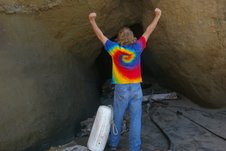 Email John ([email protected])
Email John ([email protected])
To read John’s exciting stories of adventure on the South Coast please go to pescaderomemories.com, or click here

